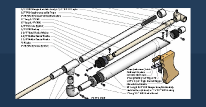Hey everyone,
Hope this is the right place to post, I wasn't sure if this belonged here, or as a concept thread.
Basically, I'm hoping to 3D print a nerf flywheel blaster using a PLA printer with a 20x20x20 print capacity, that has yet to be calibrated, but having little experience with flywheels or 3D printing, I'm going to need a little bit of advice.
Firstly, because I don't have any better ideas for aesthetics, I'm planning on making a blaster with a similar appearance to the FG42, so the gun is going to be side-fed.
I've seen very little information on this online, and I'm not sure if it's because the only gun that springs to mind with side feeding is the raider (which seems largely unpopular), or if it's because side feeding is a bad design.
Secondly, I've found little in the way of people reinforcing their larger 3D prints, like stocks and grips with cheaper, stronger material like wood/metal rods.
Given that I'm planning on 3D printing the case, I'm tossing up between this or trying to find some broken/discarded nerf shells to use as casing, and building upon those instead.
Thirdly, I've several DC motors salvaged from printers I'm hoping to use.
The two on the far left are 130s, I believe, but I'm not sure of their specifications, so it's unlikely that I'm going to be using them.
From (fairly unreliable) datasheets I've found online, it appears that the third and fourth motors are capable of producing 12-15k RPM, which is no where near as fast as the desired 20k+ that I've heard reported from Rhino MTBs or the Tamiya Plasma Drives, but I feel as though through a combination of larger flywheels (3D printing custom flywheel cages is an option), and a higher torque, these should suffice.
For reference, I gather that the current "high end" motor is the Rhino MTB, producing 36k RPM, with the 2" radius stock flywheels, this results in tangential velocity of roughly 628fps, achieving the glass ceiling of 120fps
Since I'm happy achieving around 100fps, I feel as though this is overkill, especially since I only have NiMh batteries to work with. I'm wondering if anyone has any experience with high-torque, low-RPM motors like the ones I have?
Alternatively, I'm toying around with the possibility of using the third and fourth motors in my image as afterburners, with the small ones as launchers. Also, I should be able to mimic the shape of worker wheels, since I'm 3D printing the cage and wheels, anyway.
Anyway, I've got a ton of things to figure out, and I really appreciate you guys letting me post here.






















